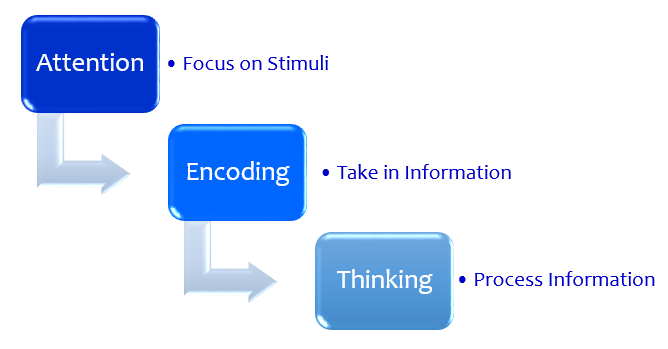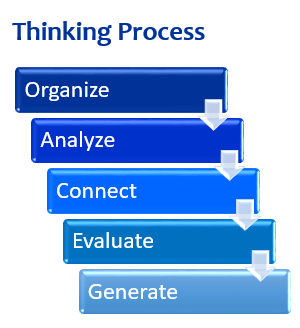Learning Process Simplified
Learning is a complex process. However, the learning process can be broken down into three fundamental parts: locating information, taking it in, and processing it.
Attention – Locating information
Encoding – Taking information in
Thinking – Processing information
Three Parts of the Learning Process
- Attention – the ability to focus and concentrate on stimuli from the environment
- Encoding – the ability to take in new information, process it, and combine it with previous knowledge
- Thinking – the ability to reason, solve problems, and make decisions

Three Parts of the Learning Process Explained
Stimuli from the environment captures our attention. We first process that information in our working memory. We may then process it in our short-term memory or into our long-term memory. If we only process it into our short-term memory, we will shortly forget it. However, if we process it into our long term memory, we will remember it for a longer period of time. For example, if a passing car gets your attention, you may process that in your short term memory only. Therefore, if a person asks you the color of the car, you may only remember for a very short period of time. Since it never reach your long-term memory, you would not recall the color a week later.
If the information is stored in your long-term memory, you can use that information to process new additional information you receive. The more information stored in long-term memory the better you can reason, solve problems, and make decisions.
Attention
The learning process starts with attention. When stimuli from the environment captures our attention, we begin to process it and learn from it. If the stimuli do not come to our attention, we cannot process it and learn from it.
Due to the vast amounts of information we encounter, we cannot pay attention to all of the stimuli in the environment all at once. Therefore, we selectively pay attention to only stimuli that captures our attention. It is typically stimuli that is interesting or meaningful to us. If the stimuli does get our attention, we will take that information into our brain to continue the cognitive processes required to interpret the information.
Encoding
The next stage of the learning process is encoding information into memory. Without encoding into memory, there can be no learning.
Information from the environment is constantly reaching our senses in the forms of stimuli. However, it is not all encoded. Encoding requires linking the stimuli from the environment to our existing knowledge. It occurs when information is translated into a form that can be processed mentally. Encoding allows us to change that stimuli so we may put it into our memory. If information or stimuli never gets encoded, it will never be remembered. Hence, information or stimuli has to be paid attention to in order to be encoded.
We need time to process the information. If we are given too much information at once and are not told which aspects of the information we should pay attention to, we probably will have difficulty learning any of the information at all.
As we process the information, we need to store it in order to retain the information over time. When we store it we create a permanent record of the encoded information. Information is stored in the memory systems, and the storage areas vary according to time frames. The period of time that information is retained is anywhere from a fraction of a second to years. Short-term memory can hold information usually about 30-45 seconds. However, long-term memory can last a lifetime.
Thinking
Thinking is the stage where the real “learning” takes place. Thinking refers to the process of creating a logical series of connective facets between items of information. Thinking enables us to connect and integrate new experiences into our existing understanding and perception of how things are.
Since the learning process requires us to relate new information to previously learned information, it is essential to be able to retrieve prior stored information.
Levels of Thinking
Learning can range from simple to complex depending on the level of thinking. The simplest thinking level involves recalling facts and figures, while higher order skills include analysis, synthesis, problem solving, and evaluation. We can learn the names of the Presidents of the United States by simply storing and then retrieving the information. We can also learn complex and abstract theories by using several levels of thinking including organizing, analyzing, evaluating, and generating.
For example, we may take in information and mentally organize it, then analyze it by breaking down information by examining its parts and relationships. After we have a good understanding of the organizational structure, we make connections between related items or pieces of information. We then may evaluate and assess the reasonableness and quality of ideas or materials on order to form an opinion. Lastly, we may begin to generate theories to validate our learning before testing those theories.

